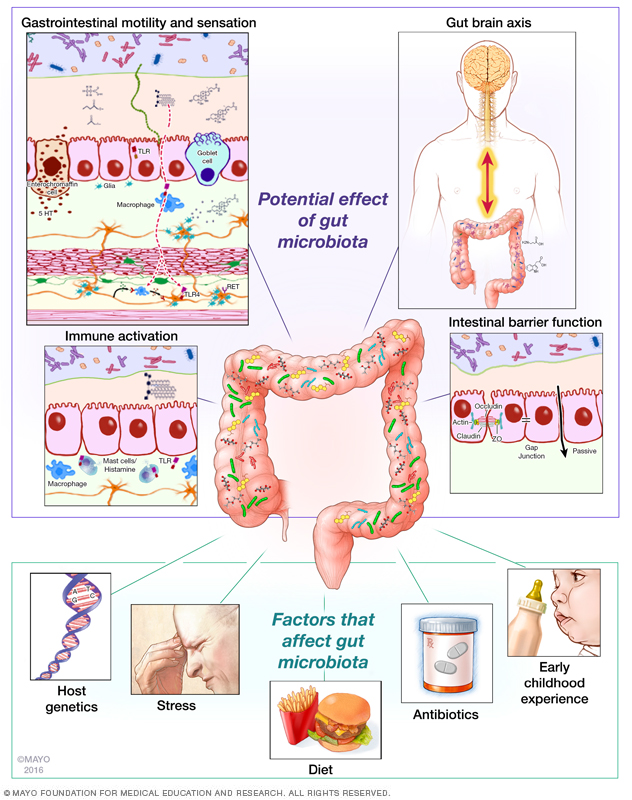Digestion and nutrients absorption are routine processes involving several organs' coordination. They are mediated by the secretion of hormones and the enteric nervous system (often designated the “second brain”) and can be substantially impacted by the microbiota.
The gastrointestinal tract (GIT) directly comprises the oral cavity, the pharynx, the oesophagus, the stomach and the small and large intestines. The main function of the tract is the assimilation of nutrients from ingested food that flows through by coordinated motility of the GIT, associated with the appropriate fluid and enzyme solutions. Consequently, the macromolecules in food are gradually digested, and the nutrients liberated are absorbed into the circulatory system. Although digestion and absorption are routine processes, they involve the coordination of several organs, mediated by the secretion of hormones and the enteric nervous system (often designated the “second brain”) (1). The following sequence concisely exemplifies the assimilation of food throughout the GIT, in order to relate the diverse actions and compositions of the microbiota throughout the tract (2):
1. Mastication and Swallowing
The food breaks in the mouth and forms a bolus suitable to be swallowed, while saliva humidifies and provides enzymes for the initial digestion. Once swallowed, the food bolus takes about 10 seconds to descend into the stomach via the oesophagus.
2. Stomach
Depending on its composition, the bolus remains in the stomach for one to four hours. The organ has three properties that contribute to the digestion. Firstly, stomach mobility mixes and divides the bolus into smaller particles. Secondly, the gastric acid dissolves and denatures proteins into small polypeptides, besides preventing pathogenic organisms present in food to reach the intestines and bloodstream. Thirdly, besides gastric acid, the gastric mucosa produces mucus, that protects the stomach cell wall, pepsinogen, that activates into pepsin when in contact with the gastric acid and breaks proteins, and gastric lipase, that is involved in fat digestion and emulsification (3). Then, the food particles pass through the pyloric sphincter and start to be absorbed by the small intestine. As well as the first part of the small intestine, the stomach contains oxygen and inhospitable physiology, with a less diverse but more aerotolerant and aerobic microbiota.
3. Small Intestine
Once in the small intestine, the digested food is blended with exocrine secretions containing bicarbonate (HCO3-), that neutralizes the acid from the stomach. The exocrine secretions also contain salts from bile and enzymes from pancreatic and intestinal juices, which are involved in the digestion of proteins, carbohydrates and fat. All the significant absorption of nutrients into the bloodstream occurs in the small intestine, where the food stays around seven to ten hours, advancing through the organ via enteric motility (4). Due to the digestive enzymes and bile of the small intestine, the organ has a less diverse and abundant microbiota than the colon, usually being dominated by species from Streptococcus, Bifidobacterium, Lactobacillus and Enterococcus genera (5).
4. Large Intestine (Colon)
Finally, the transit reaches the large intestine, starting at the cecum and ending at the sigmoid colon and taking twelve to twenty-four hours to occur. Among several functions, the large intestine is responsible for fluid and electrolyte absorption, and, with the assistance of the microbiota, the fermentation of fibre. The large intestine has the most diverse, abounding and aero-intolerant microbiota of the GIT, with a strong presence of Bacteroidetes and Firmicutes (5,6).
REFERENCES
Collen A. 10% Humanos. 1st ed. Lisboa: Objectiva Editora; 2016.
https://www.wook.pt/livro/10-humanos-alanna-collen/17436036.
Kibble JD, Halsey CR.
Gastrointestinal Physiology. In: Medical Physiology: The Big Picture.
McGraw Hill; 2009. https://accessmedicine.mhmedical.com/book.aspx?bookID=1291
Armand M, Hamosh M, DiPalma JS,
et al. Dietary fat modulates gastric lipase activity in healthy humans. Am J
Clin Nutr. 1995;62(1):74-80. doi:10.1093/ajcn/62.1.74
Ulleberg EK, Comi I, Holm H, Herud EB, Jacobsen M, Vegarud
GE. Human gastrointestinal juices intended for use in in vitro digestion
models. Food Dig. 2011;2(1-3):52-61. doi:10.1007/s13228-011-0015-4
Mailhe M, Ricaboni D, Vitton V, et al. Repertoire of the gut
microbiota from stomach to colon using culturomics and next-generation
sequencing. BMC Microbiol. 2018. doi:10.1186/s12866-018-1304-7
Hillman ET, Lu H, Yao T,
Nakatsu CH. Microbial ecology along the gastrointestinal tract. Microbes
Environ. 2017;32(4):300-313. doi:10.1264/jsme2.ME17017
ALSO...
Role of the Normal Gastrointestinal (Gut) Microbiota
The gastrointestinal microbiota is involved in multiple aspects of our metabolism, being moderately responsible for our health equilibrium.







